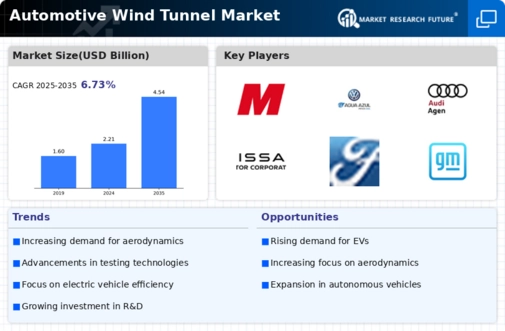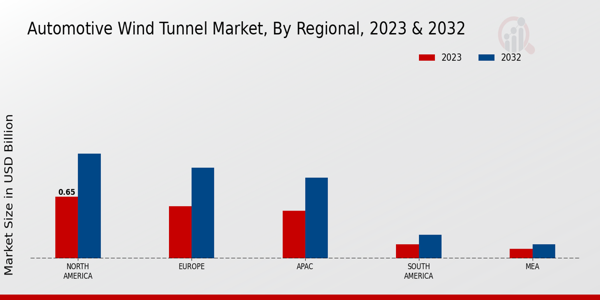Market Growth Projections
The Global Automotive Wind Tunnel Market Industry is poised for substantial growth, with projections indicating a market value of 2.21 USD Billion in 2024 and an expected increase to 4.54 USD Billion by 2035. This growth trajectory reflects a compound annual growth rate (CAGR) of 6.76% from 2025 to 2035. The increasing focus on vehicle performance, fuel efficiency, and compliance with regulatory standards are key factors driving this expansion. As automotive manufacturers continue to prioritize aerodynamic testing, the demand for wind tunnel facilities and services is likely to rise, shaping the future landscape of the industry.
Increasing Demand for Fuel Efficiency
The Global Automotive Wind Tunnel Market Industry is experiencing a surge in demand for fuel-efficient vehicles. As consumers become more environmentally conscious, automakers are compelled to enhance vehicle aerodynamics to reduce fuel consumption. Wind tunnels play a crucial role in this process, allowing manufacturers to test and optimize designs for better airflow. This trend is expected to contribute to the market's growth, with projections indicating a market value of 2.21 USD Billion in 2024. The focus on fuel efficiency aligns with global initiatives aimed at reducing carbon emissions, further driving the adoption of advanced wind tunnel technologies.
Growth of Electric and Autonomous Vehicles
The rise of electric and autonomous vehicles is reshaping the Global Automotive Wind Tunnel Market Industry. As automakers pivot towards electric mobility, the need for aerodynamic efficiency becomes paramount to maximize range and performance. Wind tunnels provide critical insights into the aerodynamic properties of these new vehicle types, allowing manufacturers to refine designs for optimal performance. This shift is expected to drive significant investments in wind tunnel facilities, as companies seek to stay competitive in a rapidly evolving market. The increasing focus on electric and autonomous vehicles may further accelerate market growth, aligning with broader trends in sustainable transportation.
Regulatory Compliance and Safety Standards
The Global Automotive Wind Tunnel Market Industry is also driven by stringent regulatory compliance and safety standards. Governments worldwide are implementing regulations that mandate specific performance criteria for vehicles, particularly concerning emissions and safety. Wind tunnels are essential for testing vehicles against these standards, ensuring that manufacturers meet legal requirements. As regulations become more rigorous, the demand for wind tunnel testing is expected to rise. This trend is likely to support the market's growth trajectory, with the industry projected to reach 4.54 USD Billion by 2035, as manufacturers invest in facilities to comply with evolving standards.
Global Expansion of Automotive Manufacturing
The Global Automotive Wind Tunnel Market Industry is benefiting from the global expansion of automotive manufacturing. Emerging markets are witnessing a rise in automotive production, leading to increased demand for wind tunnel testing facilities. Countries in Asia-Pacific and Latin America are investing in automotive infrastructure, including wind tunnels, to support local manufacturers. This expansion is likely to create new opportunities for wind tunnel service providers and equipment manufacturers. As the automotive industry continues to grow globally, the wind tunnel market is expected to flourish, driven by the need for advanced testing capabilities to enhance vehicle performance.
Technological Advancements in Wind Tunnel Design
Technological innovations in wind tunnel design are significantly influencing the Global Automotive Wind Tunnel Market Industry. Modern wind tunnels are equipped with advanced computational fluid dynamics (CFD) tools, enabling more precise simulations and testing. These advancements allow for real-time data analysis and improved accuracy in aerodynamic testing. As a result, automotive manufacturers can develop vehicles that meet stringent performance standards while minimizing drag. The integration of these technologies is likely to propel the market forward, with an anticipated growth rate of 6.76% CAGR from 2025 to 2035, reflecting the industry's commitment to innovation.









